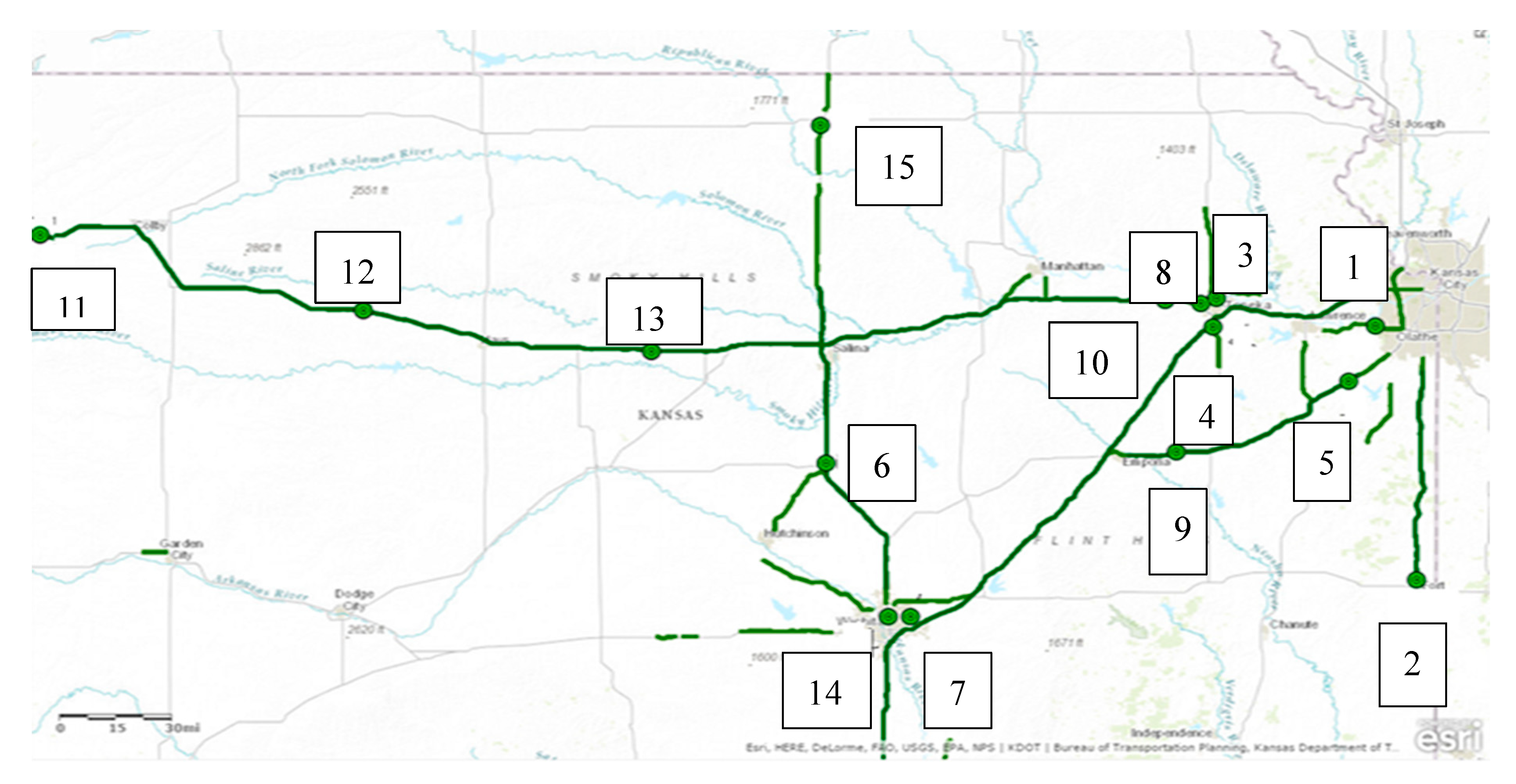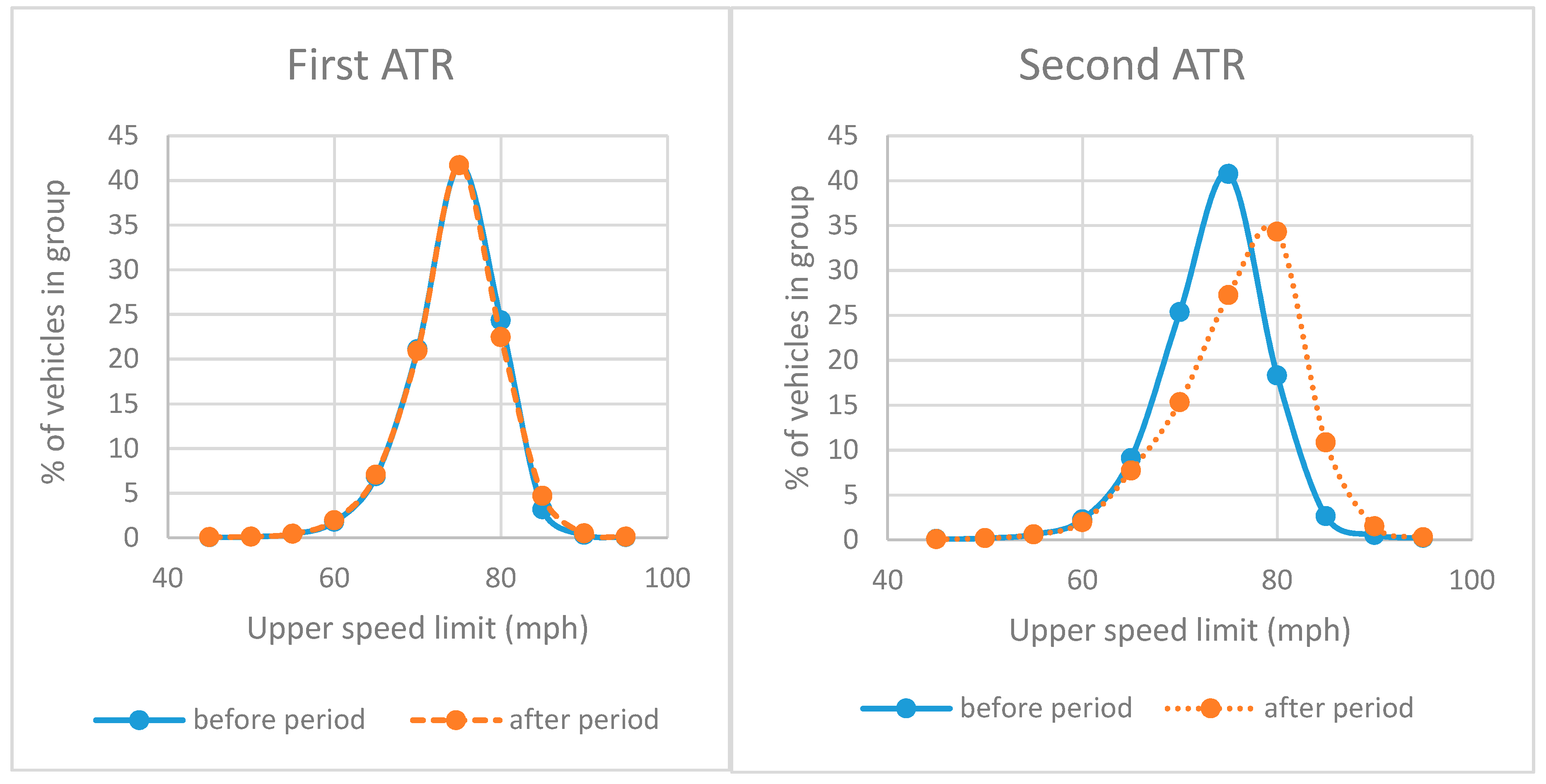Speed Characteristics in Relation to Speed Limit Increase and Its Influence on Driver’s Speed Selection Behavior
Abstract
:1. Introduction
2. Methodology
2.1. Data
2.2. Two-Tailed t-Test
- The observations from two groups (before period and after the period) are normally distributed.
- The variances of two groups are checked to see whether they are equal or not.
- The observations in each group are independent of each other.
2.3. Kolmogorov-Smirnov (K-S) Test
- : The distribution for one set of data is the same as the second set of data
- : The distribution for one set of data is different than the second set of data and the Kolmogorov-Smirnov test statistic is defined as:where,
- = the test statistic for the difference between two distributions
- & = empirical distribution functions for the first and second samples
- Sup = supremum function
- n, m = sizes of first and second sample, respectively.
3. Results
3.1. Two-Tailed t-Test Results
3.2. K-S Test Results
4. Discussion and Conclusions
Author Contributions
Funding
Conflicts of Interest
References
- Kansas Legislature Conference Committee. Kansas to Raise Rural Interstate Speed Limits to 75 MPH. April 2011. Available online: www.thenewspaper.com/news/34/3448.asp (accessed on 29 May 2017).
- Haglund, M.; Åberg, L. Speed choice in relation to the speed limit and influences from other drivers. Transp. Res. Part F Traffic Psychol. Behav. 2000, 3, 39–51. [Google Scholar] [CrossRef]
- Quimby, A.; Maycock, G.; Palmer, C.; Buttress, S. The Factors the Influence a Driver’s Choice of Speed: A Questionnaire Study; Transport Research Laboratory: Berkshire, UK, 1999. [Google Scholar]
- Islam, M.T.; El-Basyouny, K.; Ibrahim, S.E. The Impact of Lowered Residential Speed Limits in the City of Edmonton. In Proceedings of the Transportation Research Board 92nd Annual Meeting, Washington, DC, USA, 13–17 January 2013. [Google Scholar]
- Elvik, R. A restatement of the case for speed limits. Transp. Policy 2010, 17, 196–204. [Google Scholar] [CrossRef]
- Silvano, A.P.; Bang, K.L. Impact of Speed Limits and Road Characteristics on Free-Flow Speed in Urban Areas. J. Transp. Eng. 2015, 142, 04015039. [Google Scholar] [CrossRef]
- Brown, D.B.; Maghsoodloo, S.; McArdle, M.E. The Safety Impact of the 65 mph Speed Limit: A Case Study Using Alabama Accident Records. J. Saf. Res. 1991, 21, 125–139. [Google Scholar] [CrossRef]
- Najjar, Y.M.; Stokes, R.W.; Russell, E.R.; Ali, H.E.; Zhang, X. Impact of New Speed Limits on Kansas Highways; Publication K-TRAN: KSU-98-3; K-TRAN Report; Kansas Department of Transportation: Topeka, KS, USA, 2000. [Google Scholar]
- Shirazinejad, R.S.; Dissanayake, S. Analysis of Speed Characteristics before and After Speed Limit Change. In Proceedings of the Transportation Research Board 97th Annual Meeting, Washington, DC, USA, 7–11 January 2018. [Google Scholar]
- Binkowski, S.; Maleck, T.; Taylor, W.; Czewski, T. Evaluation of Michigan 70-mph Speed Limit. Transportation Research Record. J. Transp. Res. Board 1998, 1640, 37–46. [Google Scholar] [CrossRef]
- Souleyrette, R.R.; Stout, T.B.; Carriquiry, A. Evaluation of Iowa’s 70 Mph Speed Limit: 2.5 Year Update; CTRE Project 06-247; Centre for Transportation Research and Education, Iowa State University: Ames, IA, USA, 2009. [Google Scholar]
- Aronsson, K.F.; Bang, K.L. Speed Characteristics of Urban Streets Based on Driver Behavior Studies and Simulation Including Pedestrian Movements. In Proceedings of the Transportation Research Board 86th Annual Meeting, Washington, DC, USA, 21–25 January 2007. [Google Scholar]
- Brackett, Q.; Ball, K. The Safety Impact of the 65 mph Speed Limit in Texas: A Thirty-Six Month Evaluation; Human Factors Division, Texas Transportation Institute, Texas A & M University: College Station, TX, USA, 1990. [Google Scholar]
- Wang, J. Operating Speed Models for Low-Speed Urban Environments Based on In-Vehicle GPS; Publication UMI-32-12319; Northwestern University: Evanston, IL, USA, 2006. [Google Scholar]
- AASHTO. Highway Safety Manual; American Association of State Transportation Officials: Washington, DC, USA, 2014; Volume 1. [Google Scholar]
- Brandt, S.; Brandt, S. Data Analysis: Statistical and Computation Methods for Scientists and Engineers; Springer: New York, NY, USA, 1999. [Google Scholar]
- Stata Statistical Software: Release 14; Stata Corp: College Station, TX, USA, 2015.
- Montgomery, D.C.; Runger, G.C.; Humble, N.F. Engineering Statistics; John Wiley and Sons, Inc.: New York, NY, USA, 2009. [Google Scholar]
- Pham, H. (Ed.) Springer Handbook of Engineering Statistics; Springer Science & Business Media: Berlin, Germany, 2006. [Google Scholar]
- R Development Core Team. R: A Language and Environment for Statistical Computing; R Foundation for Statistical Computing: Vienna, Austria, 2013; Available online: http://www.R-project.Org (accessed on 15 May 2018).



| ATR Number(Rural/Urban) | Site Characteristic | Data Availability | ||
|---|---|---|---|---|
| Control Site | Treated Site | The Year 2010 | The Year 2012 | |
| 1-EFPRX3(rural) | ✓ | March, September, December | January to December | |
| 2-F10VD5(rural) | ✓ | June | January to December | |
| 3-CXJUQ3(rural) | ✓ | June, September, November, and December | January to December | |
| 4-CXSRG1(urban) | ✓ | September, November, and December | January to December | |
| 5-E7PK42(urban) | ✓ | December | January to December | |
| 6-94J8N1(rural) | ✓ | September and December | January to December | |
| 7-A0OOS8(rural) | ✓ | March, June, September, and December | January to December | |
| 8-CB1U73(rural) | ✓ | September and December | January to December | |
| 9-CO1AY7 (rural) | ✓ | March, June, and September | January to December | |
| 10-CTGTW8 (urban) | ✓ | September, November, and December | January to December | |
| 11-0DT453 (urban) | ✓ | September and December | January to December | |
| 12-4LGSU7 (rural) | ✓ | September and December | January to December | |
| 13-7FGNB7 (rural) | ✓ | September and December | January to December | |
| 14-9Q9OK1 (rural) | ✓ | March to June, September and December | January to December | |
| 15-91TFY5 (urban) | ✓ | September and December | January to December | |
| ATR# | Treated/Control Site | Sample Size | Before | After | t-Value | Two-Tailed t-Test | ||
|---|---|---|---|---|---|---|---|---|
| Before the Period | After the Period | 85th Percentile Speed (mph) | 85th Percentile Speed (mph) | p-Value | Statistically Significant Difference (Yes/No) | |||
| 1 | Control | 1,401,188 | 3,031,690 | 77.65 | 77.83 | −32.14 | 0.00 | Yes |
| 2 | Treated | 77,496 | 397,177 | 76.82 | 79.65 | −128.00 | 0.00 | Yes |
| 3 | Treated | 1,409,912 | 5,226,224 | 74.42 | 74.28 | 26.92 | 0.00 | Yes |
| 4 | Control | 315,487 | 1,272,566 | 75.50 | 75.67 | −14.16 | 0.00 | Yes |
| 5 | Treated | 282,760 | 601,588 | 77.32 | 79.72 | −184.00 | 0.00 | Yes |
| 6 | Control | 816,304 | 2,646,833 | 72.50 | 72.37 | 21.00 | 0.00 | Yes |
| 7 | Treated | 868,023 | 1,127,571 | 78.40 | 80.89 | −276.00 | 0.00 | Yes |
| 8 | Treated | 427,132 | 1,216,287 | 77.72 | 80.02 | −232.00 | 0.00 | Yes |
| 9 | Treated | 676,551 | 2,326,592 | 69.11 | 69.33 | −27.50 | 0.00 | Yes |
| 10 | Treated | 231,817 | 375,564 | 77.03 | 81.29 | −266.00 | 0.00 | Yes |
| 11 | Treated | 273,166 | 310,952 | 77.37 | 81.23 | −241.00 | 0.00 | Yes |
| 12 | Treated | 4,411,134 | 8,814,389 | 68.94 | 69.21 | −100.00 | 0.00 | Yes |
| 13 | Control | 144,368 | 222,132 | 76.13 | 75.72 | 22.77 | 0.00 | Yes |
| ATR# | Treated/Control Site | Sample Size | Before | After | Two-Tailed t-Test | ||
|---|---|---|---|---|---|---|---|
| Before the Period | After the Period | Average Speed (mph) | Average Speed (mph) | p-Value | Statistically Significant Difference (Yes/No) | ||
| 1 | Control | 1,401,188 | 3,031,690 | 71.95 | 72.00 | 0.00 | Yes |
| 2 | Treated | 77,496 | 397,177 | 71.09 | 73.56 | 0.00 | Yes |
| 3 | Treated | 1,409,912 | 5,226,224 | 69.04 | 68.68 | 0.00 | Yes |
| 4 | Control | 315,487 | 1,272,566 | 70.08 | 69.71 | 0.00 | Yes |
| 5 | Treated | 282,760 | 601,588 | 71.74 | 73.66 | 0.00 | Yes |
| 6 | Control | 816,304 | 2,646,833 | 67.34 | 67.15 | 0.00 | Yes |
| 7 | Treated | 868,023 | 1,127,571 | 73.15 | 73.46 | 0.00 | Yes |
| 8 | Treated | 427,132 | 1,216,287 | 72.04 | 74.07 | 0.00 | Yes |
| 9 | Treated | 676,551 | 2,326,592 | 63.21 | 63.53 | 0.00 | Yes |
| 10 | Treated | 231,817 | 375,564 | 71.26 | 74.19 | 0.00 | Yes |
| 11 | Treated | 273,166 | 310,952 | 71.50 | 74.34 | 0.00 | Yes |
| 12 | Treated | 4,411,134 | 8,814,389 | 64.03 | 64.31 | 0.00 | Yes |
| 13 | Control | 144,368 | 222,132 | 70.76 | 70.38 | 0.00 | Yes |
| ATR# | Treated/Control Site | Test Statistic (D) | Critical D | p-Value | Statistically Significant Difference (Yes/No) |
|---|---|---|---|---|---|
| 1 | Control | 0.0012 | 0.0013 | 0.99 | No |
| 2 | Treated | 0.0912 | 0.0050 | 0.046 | Yes |
| 3 | Treated | 0.0010 | 0.0012 | 0.99 | No |
| 4 | Control | 0.0019 | 0.0027 | 0.99 | No |
| 5 | Treated | 0.2723 | 0.0031 | 0.038 | Yes |
| 6 | Control | 0.0011 | 0.0017 | 0.99 | No |
| 7 | Treated | 0.2774 | 0.0019 | 0.042 | Yes |
| 8 | Treated | 0.1845 | 0.0024 | 0.046 | Yes |
| 9 | Treated | 0.0943 | 0.0018 | 0.039 | Yes |
| 10 | Treated | 0.2245 | 0.0036 | 0.042 | Yes |
| 11 | Treated | 0.3674 | 0.0035 | 0.038 | Yes |
| 12 | Treated | 0.0064 | 0.0007 | 0.041 | Yes |
| 13 | Control | 0.0032 | 0.0046 | 0.99 | No |
© 2020 by the authors. Licensee MDPI, Basel, Switzerland. This article is an open access article distributed under the terms and conditions of the Creative Commons Attribution (CC BY) license (http://creativecommons.org/licenses/by/4.0/).
Share and Cite
Shirazinejad, R.S.; Dissanayake, S. Speed Characteristics in Relation to Speed Limit Increase and Its Influence on Driver’s Speed Selection Behavior. Sustainability 2020, 12, 1369. https://doi.org/10.3390/su12041369
Shirazinejad RS, Dissanayake S. Speed Characteristics in Relation to Speed Limit Increase and Its Influence on Driver’s Speed Selection Behavior. Sustainability. 2020; 12(4):1369. https://doi.org/10.3390/su12041369
Chicago/Turabian StyleShirazinejad, Reza S., and Sunanda Dissanayake. 2020. "Speed Characteristics in Relation to Speed Limit Increase and Its Influence on Driver’s Speed Selection Behavior" Sustainability 12, no. 4: 1369. https://doi.org/10.3390/su12041369
APA StyleShirazinejad, R. S., & Dissanayake, S. (2020). Speed Characteristics in Relation to Speed Limit Increase and Its Influence on Driver’s Speed Selection Behavior. Sustainability, 12(4), 1369. https://doi.org/10.3390/su12041369





